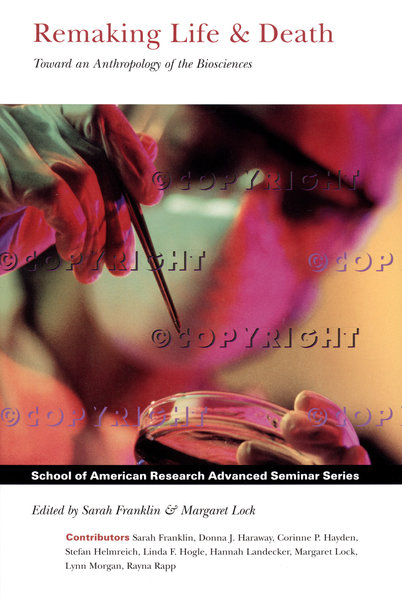Remaking Life & Death
Toward an Anthropology of the Biosciences
Edited by Sarah Franklin and Margaret Lock
The boundaries of life now occupy a place of central concern among biological anthropologists. Because of the centrality of the modern biological definition of life to Euro-American medicine and anthropology, the definition of life itself and its contestation exemplify competing uses of knowledge. On the one hand, “life” and “death” may be redefined as partial or contingent (“brain death”), or reconstituted altogether (“virtual” or “artificial life”). On the other hand, the finality and “reality” of death resists such classifications. This volume reflects a growing international concern about issues such as organ transplantation, new reproductive and genetic technologies and embryo research, and the necessity of cross-cultural comparison. The political economy of body parts, organ and tissue “harvesting,” bio-prospecting, and the patenting of life-forms are explored herein, as well as governance and regulation in cloning, organ transplantation, tissue engineering, and artificial life systems procedures.
2003. 392 pp., 9 black-and-white illustrations, 1 table, notes, references, index, 6 x 9
Contributors: Sarah Franklin, Donna Haraway, Corinne P. Hayden, Stefan Helmreich, Linda F. Hogle, Hannah Landecker, Margaret Lock, Lynn Morgan, Rayna Rapp
Download an excerpt.
“The essays compiled in this book map broad changes in the continuously evolving conceptions of ‘life’ and ‘death’ as brought about by developments in contemporary science….[E]ach chapter might potentially have a formative influence on its own field and related literature. The book is therefore a seminal contribution to the broader field of inquiry.”
—Dr. Diana Gibson, Medische Antropologie
“The issues addressed in this book…are urgent matters of public debate as well as issues of scholarly interest. Without exception, the chapters all advance novel arguments and contribute to the literature on bioethics and the anthropology of science. [They] are written with a fluency and readability that makes them engaging.”
—Dr. Hugh Gusterson, Massachusetts Institute of Technology
“This volume…is an impressive deepening and specification of the sort of systematic work that is being done in and on biosciences. The command of complex developments in scientific research is impressive, [and it] is a model of what a synthetic report on an emerging research field should be. [It] will not only be read widely by scholars in science studies, but also…by a wide range of anthropologists.”
—George Marcus, Rice University
“Ten contributions from biological and medical anthropologists consider the social implications of recent advances in biotechnology. A sampling of topics includes the commodification of the organs of brain dead patients; the reactions of various governments to cloning technologies; and the medical experiences of persons with genetic illnesses.”
—SciTech Book News, December 2004
“The contributors to this book, in a brilliant manner, show how—from one perspective—life sciences are constitutive contributors to social practices, beliefs, and expectations, and from the other viewpoint, they are products and practices embedded in cultural identities, social practices, discourses, and institutions. . . . This book is [an] indispensable part of any work on bioeconomy. It will be the inspiration for death studies as [a] contribution to the knowledge of how life sciences reinterpret our ideas of life and death.”
—Anna E. Kubiak, Polish Academy of Sciences, Death Studies, 13 March 2017
List of figures
List of Tables
Foreword by Jonathan Haas
Preface
Acknowledgments
Part I Introduction
-
- Olmec Studies: a status report
Robert J. Sharer - Olmec: what’s in a name?
David C. Grove
- Olmec Studies: a status report
Part II The Olmec Heartland
-
- Olmec archaeology: what we know and what we wish we knew
Richard A. Diehl - The heartland Olmec: evolution of material culture
Gareth W. Lowe - The heartland Olmec: evolution of ideology
Michael D. Coe
- Olmec archaeology: what we know and what we wish we knew
Part III The Olmec Heartland
-
- Coapexco and Tlatilco: sites with Olmec materials in the Basin of Mexico
Paul Tolstoy - Chalcatzingo and its Olmec connection
David C. Grove - Zapotec chiefdoms and the nature of Formative religions
Joyce Marcus - Chiapas and the Olmec
Thomas A. Lee, Jr. - Olmec diffusion: a sculptural view from Pacific Guatemala
John Graham - The Olmec and the Southeast periphery of Mesoamerica
Robert J. Sharer
- Coapexco and Tlatilco: sites with Olmec materials in the Basin of Mexico
Part IV Conclusions
- Western Mesoamerica and the Olmec
Paul Tolstoy - The Olmec and the rise of civilization in eastern Mesoamerica
Arthur Demarest
